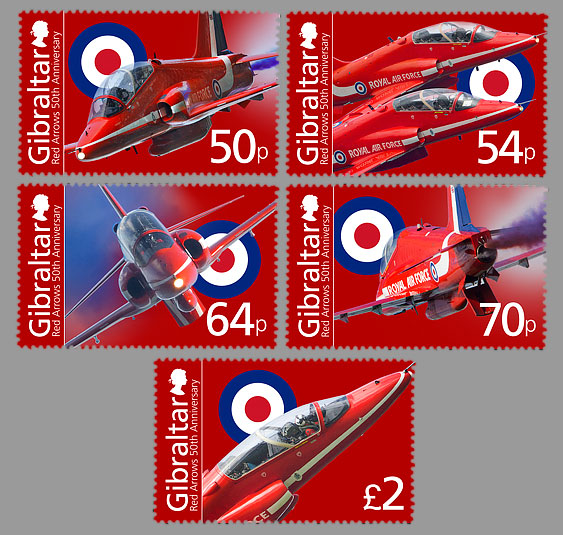Home -> Stamps -> 2014 -> 50th Anniversary of the Red Arrows -> Set
We also recommend:

Red Arrows (view technical specs)
The Red Arrows, officially known as the Royal Air Force Aerobatic Team, is the aerobatics display team of the Royal Air Force based at RAF Scampton. The team was formed in late 1964 as an all-RAF team, replacing a number of unofficial teams that had been sponsored by RAF commands.
The Red Arrows badge shows the aircraft in their trademark diamond nine formation, with the motto ‘Éclat’, meaning ‘brilliance’ or ‘excellence’.
Initially, they were equipped with 7 Folland Gnat trainers inherited from the RAF Yellowjacks display team. This aircraft was chosen because it was less expensive to operate than front-line fighters. In their first season, they flew at 65 shows across Europe. In 1966, the team was increased to 9 members, enabling them to develop their Diamond Nine formation. In late 1979, they switched to the BAE Hawk trainer. The Red Arrows have performed over 4,000 displays worldwide in 52 countries.
The team use the same two-seat training aircraft used for advanced pilot training, at first the Hawker Siddeley Gnat which was replaced in 1979 by the BAE Hawk T1. The Hawks are modified with an uprated engine and a modification to enable smoke to be generated.
The smoke trails left by the team are made by releasing diesel into the exhaust; this oxidises straight away, leaving a white smoke trail. Dyes can be added to produce the red and blue colour. The diesel is stored in the pod on the underside of the plane; it houses three tanks: one 50-imperial-gallon (230 L) tank of pure diesel and two 10-imperial-gallon (45 L) tanks of blue and red-dyed diesel. The smoke system uses 10-imperial-gallon (45 L) per minute; therefore each plane can trail smoke for a total of seven minutes - 5 minutes of white smoke, 1 minute of blue smoke and 1 minute of red smoke.
The first display by the Red Arrows was at RAF Little Rissington on 6 May 1965. The display was to introduce the Royal Air Force Aerobatic Team to the media. However, the first public display was on 9 May 1965 in France, at the French National Air Day in Clermont-Ferrand. The first public display in the UK was on 15 May 1965 at the Biggin Hill International Air Fair. The first display with nine aircraft was on 8 July 1966 at RAF Little Rissington.
During displays, the aircraft do not fly directly over the crowd apart from entering the display area by flying over the crowd from behind; any manoeuvres in front of and parallel to the audience can be as low as 300 feet, the ‘synchro pair’ can go as low as 100 feet straight and level, or 150 feet when in inverted flight. To carry out a full looping display the cloud base must be above 4,500 feet to avoid the team entering the cloud while looping If the cloud base is less than 4,500 ft but more than 2,500 ft the Team will perform the Rolling Display, substituting wing-overs and rolls for the loops. If the cloud base is less than 2,500 ft the Team will fly the Flat Display, which consists of a series of fly-pasts and steep turns.
Since 1966, there have been 9 display pilots each year, all volunteers. Pilots must have completed 1 or more operational tours on Tornados, Harriers or Jaguar jets, have accumulated at least 1,500 flying hours and have been assessed as above average in their operational role to be eligible. Even then, there are more than ten applicants for each place on the team. Pilots stay with the Red Arrows for a 3-year tour of duty. 3 pilots are changed every year, such that there are always 3 first year pilots, 3 second year pilots, and 3 in their final year.
Technical Specs
| Design: | Stephen Perera |
| Illustration / Photography: | © Rich Andrews |
| Printer: | Lowe Martin Security Printers |
| Process: | Offset Lithography |
| Colours: | 4 colours |
| Stamp size: | 48 x 30mm,Sheetlet Size: 130 x 147mm |
| Issue date: | 2014-03-20 |
| Stamp Values: | 50p, 54p, 64p, 70p, £2 |













